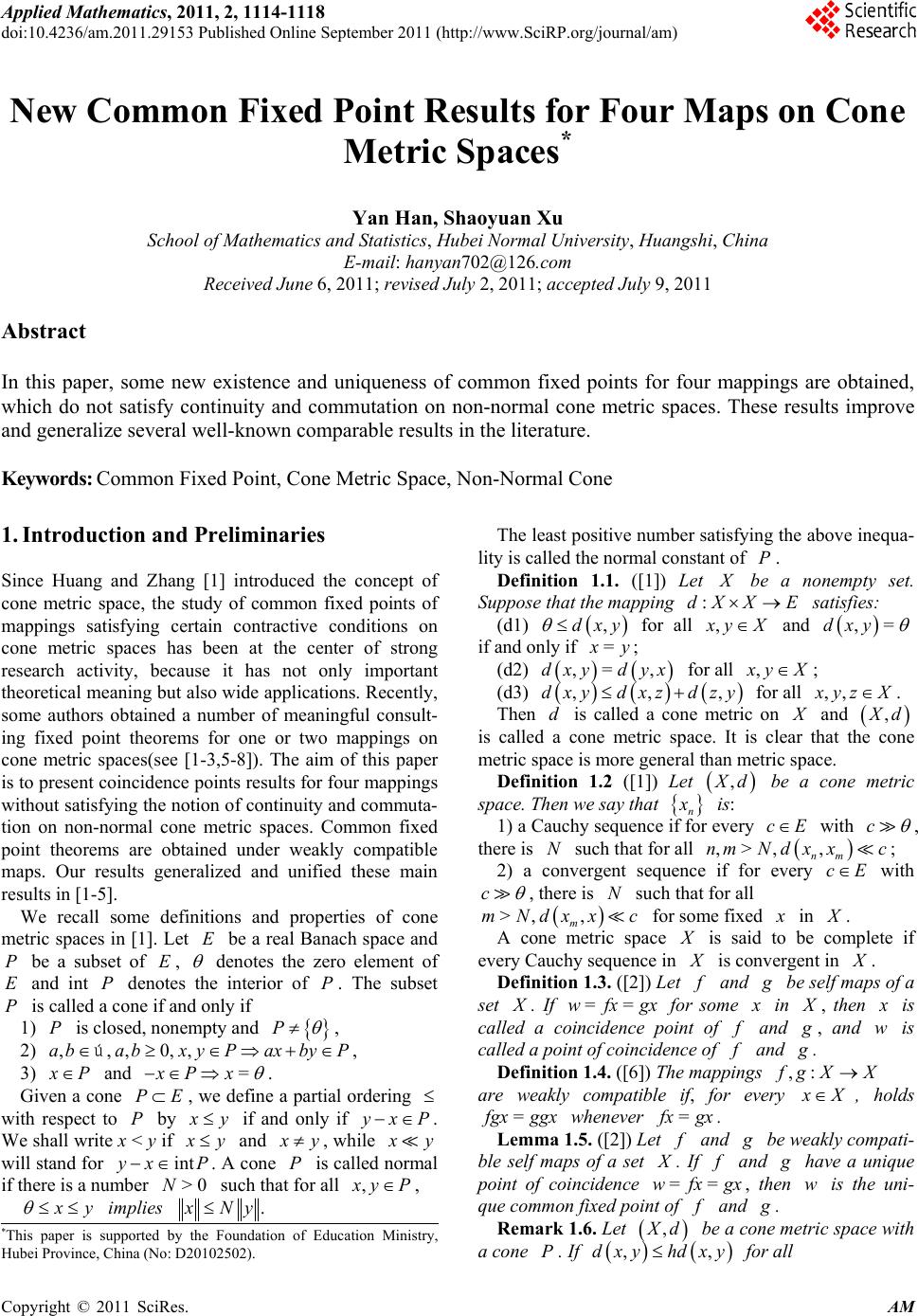 Applied Mathematics, 2011, 2, 1114-1118 doi:10.4236/am.2011.29153 Published Online September 2011 (http://www.SciRP.org/journal/am) Copyright © 2011 SciRes. AM New Common Fixed Point Results for Four Maps on Cone Metric Spaces* Yan Han, Shaoyuan Xu School of Mathematics and Statistics, Hubei Normal University, Huangshi, China E-mail: hanyan702@126.com Received June 6, 2011; revised July 2, 2011; accepted July 9, 2011 Abstract In this paper, some new existence and uniqueness of common fixed points for four mappings are obtained, which do not satisfy continuity and commutation on non-normal cone metric spaces. These results improve and generalize several well-known comparable results in the literature. Keywords: Common Fixed Point, Cone Metric Space, Non-Normal Cone 1. Introduction and Preliminaries Since Huang and Zhang [1] introduced the concept of cone metric space, the study of common fixed points of mappings satisfying certain contractive conditions on cone metric spaces has been at the center of strong research activity, because it has not only important theoretical meaning but also wide applications. Recently, some authors obtained a number of meaningful consult- ing fixed point theorems for one or two mappings on cone metric spaces(see [1-3,5-8]). The aim of this paper is to present coincidence points results for four mappings without satisfying the notion of continuity and commuta- tion on non-normal cone metric spaces. Common fixed point theorems are obtained under weakly compatible maps. Our results generalized and unified these main results in [1-5]. We recall some definitions and properties of cone metric spaces in [1]. Let be a real Banach space and be a subset of , E P E denotes the zero element of and int denotes the interior of . The subset is called a cone if and only if E P P P 1) is closed, nonempty and P P ax by , 2) , ,, ,0, ,abx yPP úab 3) P=xP x and . Given a cone , we define a partial ordering PE with respect to by P y if and only if xP . We shall write x < y if y and y, while y will stand for . A cone is called normal if there is a number such that for all intyx N P >0 P , yP , . yimpliesxN y The least positive number satisfying the above inequa- lity is called the normal constant of . P Definition 1.1. ([1]) Let be a nonempty set. Suppose that the mapping satisfies: :X EdX (d1) ,dxy for all , yX and ,=dxy if and only if = y; (d2) ,= ,dxydyx for all , yX; (d3) dzy ,,,dxydxz for all ,, yz X . Then is called a cone metric on d and , d is called a cone metric space. It is clear that the cone metric space is more general than metric space. Definition 1.2 ([1]) Let , d be a cone metric space. Then we say that n is: 1) a Cauchy sequence if for every with cEc , there is such that for all ; N ,>nm x c c E , ,N dx nm 2) a convergent sequence if for every with c , there is such that for all N x>,mN ,dx c m for some fixed in . A cone metric space is said to be complete if every Cauchy sequence in is convergent in . Definition 1.3. ([2]) Let and be self maps of a set . If for some ==wfxgx in , then is called a coincidence point of and , and is called a point of coincidence of w and . Definition 1.4. ([6]) The mappings ,: gX X are weakly compatible if, for every X, holds = gxggx whenever = xgx. Lemma 1.5. ([2]) Let and be weakly compati- ble self maps of a set . If and have a unique point of coincidence , then is the uni- que common fixed point of ==xwf gxw and . Remark 1.6. Let , d be a cone metric space with a cone . If P dx dxy,y h *This paper is supported by the Foundation of Education Ministry, Hubei Province, China No: D20102502 . , for all 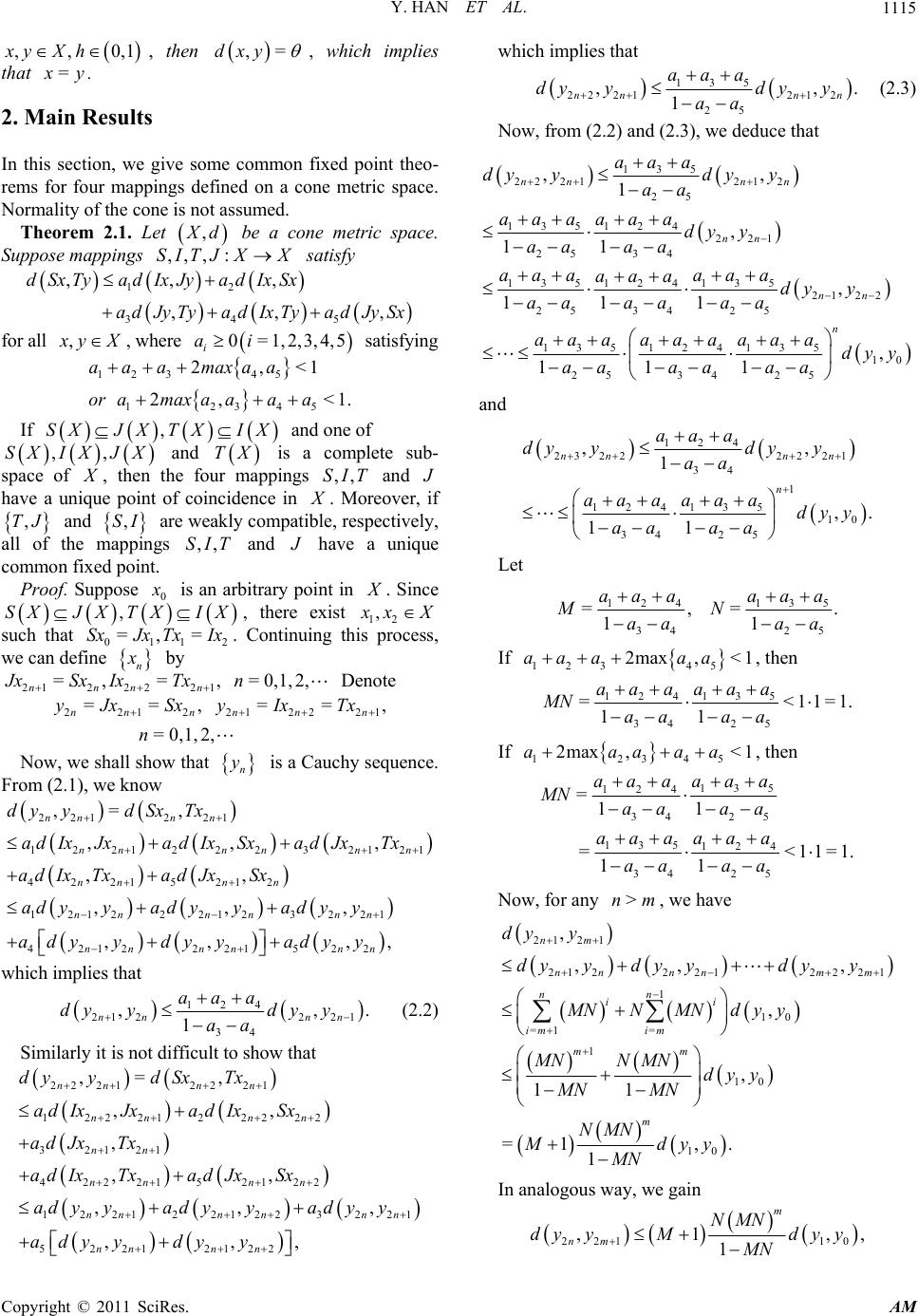 Y. HAN ET AL.1115 1 ,, 0,xyX h , then ,=dxy , which implies that = y. 2. Main Results In this section, we give some common fixed point theo- rems for four mappings defined on a cone metric space. Normality of the cone is not assumed. Theorem 2.1. Let , d , :J XX 12 34 ,, adIxSx adIxTy be a cone metric space. Suppose mappings satisfy ,,SIT dSxTy a a d , 5 ,,,dIxJy Jy Tya dJySx , for all yX, where , 4,5 i0= 1, 2,3ai satisfying 45 123 2, 2, maxaa aa a IX 12 aa or a SX JX ,,SX IXJX 3 45 < a max a <1 1. If and one of and , T X TX is a complete sub- space of , then the four mappings and ,,SIT have a unique point of coincidence in . Moreover, if and ,TJ ,SI are weakly compatible, respectively, all of the mappings and ,,TSI have a unique common fixed point. Proof. Suppose 0 is an arbitrary point in . Since , there exist 12 , SXJX T X XI, xX such that 011 . Continuing this process, we can define 2 =Ix=,Tx Sx Jx n by Denote 212 2 =, nn JxSx Ix 2 21 == nn yJx n 2n2 =Tx Sx 1 , =0,1, n n 21 2 , = , nn y Ix 2, 22 21 =0,1, 2 n n =,Tx Now, we shall show that n is a Cauchy sequence. From (2.1), we know 221 12 21 4221 1 212 4212 ,= nn nn nn nn n n dy yd a dIxJx ad IxTx ad yy ady y 2 2321 21 5 22 21 522 , ,, n n n nn nn Sx T a ddJxTx ad ad yyy dydy y 21 2 2 212 212 3 221 , ,, ,, ,, ,, n n n n n nn nn x Ix Sxa Jx Sx y ad y a , which implies that 21 ,,. 1nn y , 124 2 34 aaa dy aa 22 21 2 22 5 21 2122 21 22 , ,, ,, ,, ,, n n n n n n n n Tx d IxSx d JxSx y y y y 21 2nn dy y 22 21 122 2 321 422 1221 52 21 ,= , nn nn nn nn nn nn dy y a dIxJx ad JxTx ad IxTx adyy ady y (2.2) Similarly it is not difficult to show that 1 22 21 2122 2 3221 , n n nn dSx a a ad adyy d which implies that 135 22 21212 25 ,, 1 nn nn aaa dyydy y aa . (2.3) Now, from (2.2) and (2.3), we deduce that 135 22 21212 25 135 12 4 221 25 34 135 135 12 4 21 22 25 3425 135 135 12 4 1 2534 25 ,, 1 , 11 , 111 111 nn nn nn nn n aaa dyydy y aa aaa aaa dy y aa aa aaa aaa aa ady y aa aa aa aaa aaa aaa dy aaaaaa 0 ,y and 12 4 23 2222 21 34 1 135 12 4 10 34 25 ,, 1 ,. 11 nn nn n aaa dy ydyy aa aaa aaa dyy aa aa Let 135 124 34 25 =, =. 11 aaa aaa MN aa aa If 123 45 2max,<1aa aaa, then 135 124 34 25 =< 11 aaa aaa MN aa aa 11=1. If 12345 2max,< 1aaaaa , then 135 124 34 25 135 124 34 25 =11 =< 11 aaa aaa MN aa aa aaa aaa aa aa 11=1. Now, for any , we have >nm 2121 212221222 1 1 10 =1 = 1 10 10 , ,, , , , 11 =1 ,. 1 nm nnnnm m nn ii im im mm m dyy dyydy ydyy MNNMNd yy MNN MNdyy MN MN NMN Mdyy MN In analogous way, we gain 221 10 ,1 1 m nm NMN dy yMdyy MN ,, Copyright © 2011 SciRes. AM 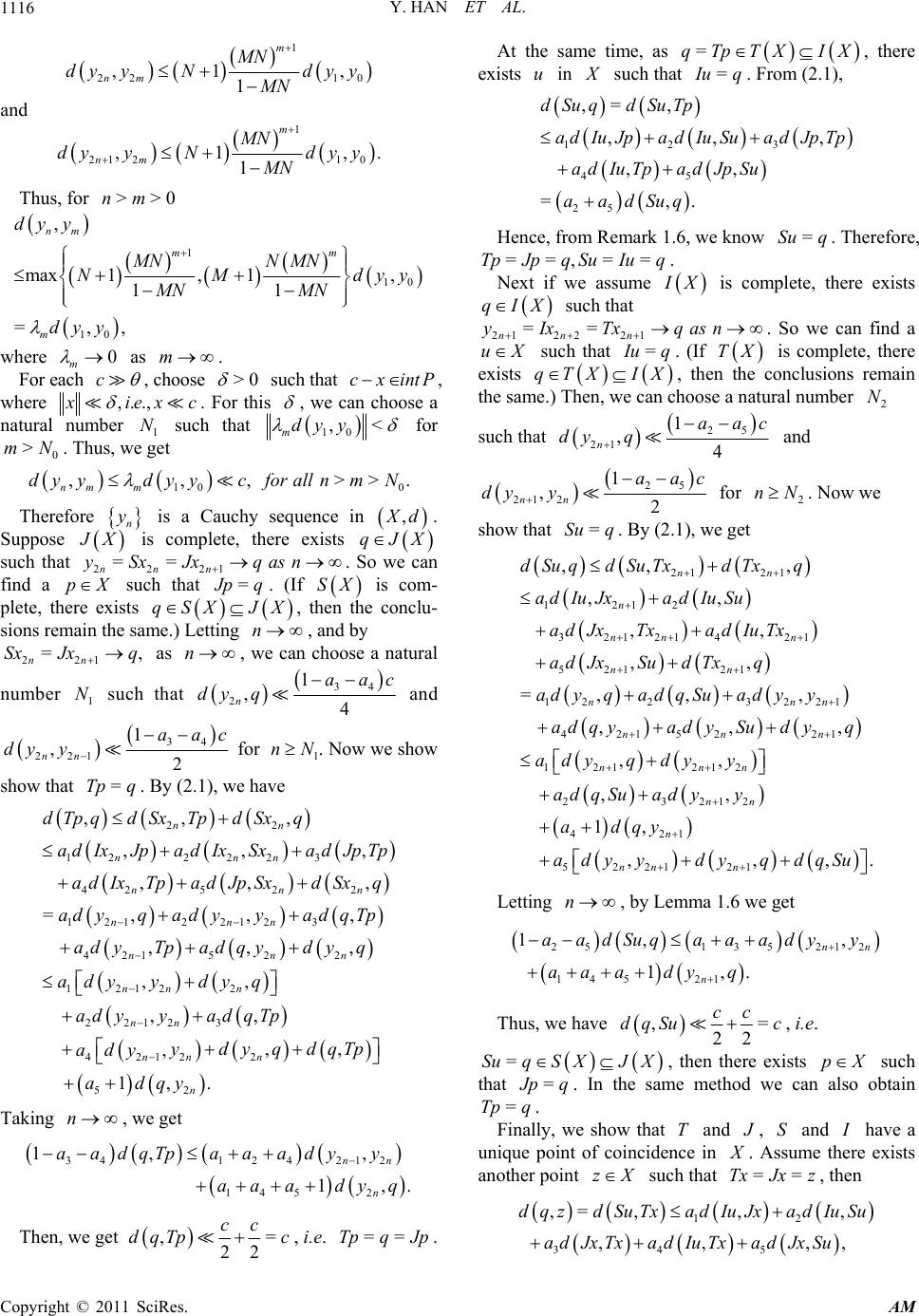 Y. HAN ET AL. 1116 1 22 10 ,1 1 m nm MN dy yNdyy MN , and 1 21 21 0 ,1 1 m nm MN dy yNdyy MN ,. Thus, for >>0nm 1 10 10 , max1,1, 11 =,, nm mm m dyy MNN MN NM d MN MN dyy yy where 0 m c as . m For each , choose >0 such that cxintP , where , .., ie x c. For this , we can choose a natural number 1 such that N 10 ,< mdyy > for . Thus, we get 0 >mN 10 0 ,,, > nm m d yydyycforallnmN . Therefore n is a Cauchy sequence in , d. Suppose X is complete, there exists qJX such that 2. So we can find a such that 22 yS X 1 == nnn xJx qasn = p pq SX qSX JX n . (If is com- plete, there exists , then the conclu- sions remain the same.) Letting , and by 221 =, nn Sx Jxq as , we can choose a natural n number such that 1 N 34 2 1 ,4 n aac dy q and 34 221nn y 1 ,2 aac dy , , n n . for 1 n. Now we show N show that . By (2.1), we have =Tp q 22 12222 3 425 22 1212212 3 4215 22 1212 2 2212 3 421 ,, , ,, ,, =,, , ,, , ,, ,, , nn nnn nn nnn nn nn n nn n dTpqdSx TpdSxq a dIxJpadIxSxadJpTp ad IxTpadJpSxd Sxq ad yqad yyadqTp ad yTpadqyd yq adyydyq adyyad qTp ady 22 52 ,, 1,. nn n ydyqdqTp adqy Taking , we get n 34124 212 145 2 1, , 1, nn n aadqTp aaady y aaa dyq Then, we get ,= dq Tp qJp . =qTpTXIX 22 ccc, i.e. At the same time, as ==Tp , ther ex e ists u in such that = uq . From (2.1), 123 45 25 , ,, ,, =,. d q adIuJpadIuSua dJp Tp ad IuTpadJpSu aadSuq = ,Su dSuTp , Hence, from Remark 1.6, we know Therefore, Next if we assume =Suq. ==,==JpqSuIuq . Tp X is complete, there exists IX such that 2221n n x q 21n y uX ==IxT asn q . So we can find a such that = uq. (If TX is complete, there exists X n c qTX, thenonclusions remain the samhoose a natural number 2 N such that I the c .) Then, we cae 25 1 ,aac dy q and 21 4 n 25 21 2 1 ,2 nn aac dyy for . Now we show that . By (2.1), w 2 nN =Su qe get 21 21 1212 321214 21 521 21 12 23221 42152 21 121 212 23 , , ,, ,, ,, =, ,, ,, ,, , nn n nn n nn nn nnn nnn q dq adIuJxa dIuSu a dJxTxa dIu Tx adJxSud Txq ad yqadqSuadyy adqyadySudyq adyq dyy ad qSuady 21 2 421 52 2121 , 1, ,, nn n nnn y adqy ady ydyqdqSu ,dSuSuTx dTx , n ,. Letting , by Lemma 1.6 we get n 25135 212 145 21 1, . nn n ady aa adyq 1,aSuq aaady , Thus, we have ,= 22 cc dqSu c, i.e. SuJ X=qS X ists pX, then there ex such that = pq. In the sam q. e method we canobtain =Tp also Finally, we show that and T , S and have a unique point of coinciden in ce . Assume there exists another point zX such that ==Jxz , then Tx 12 345 , ,,, dSuJx ad ad JxTxadIuTxad JxSu ,= ,,dqzTx adIuIuSu , Copyright © 2011 SciRes. AM 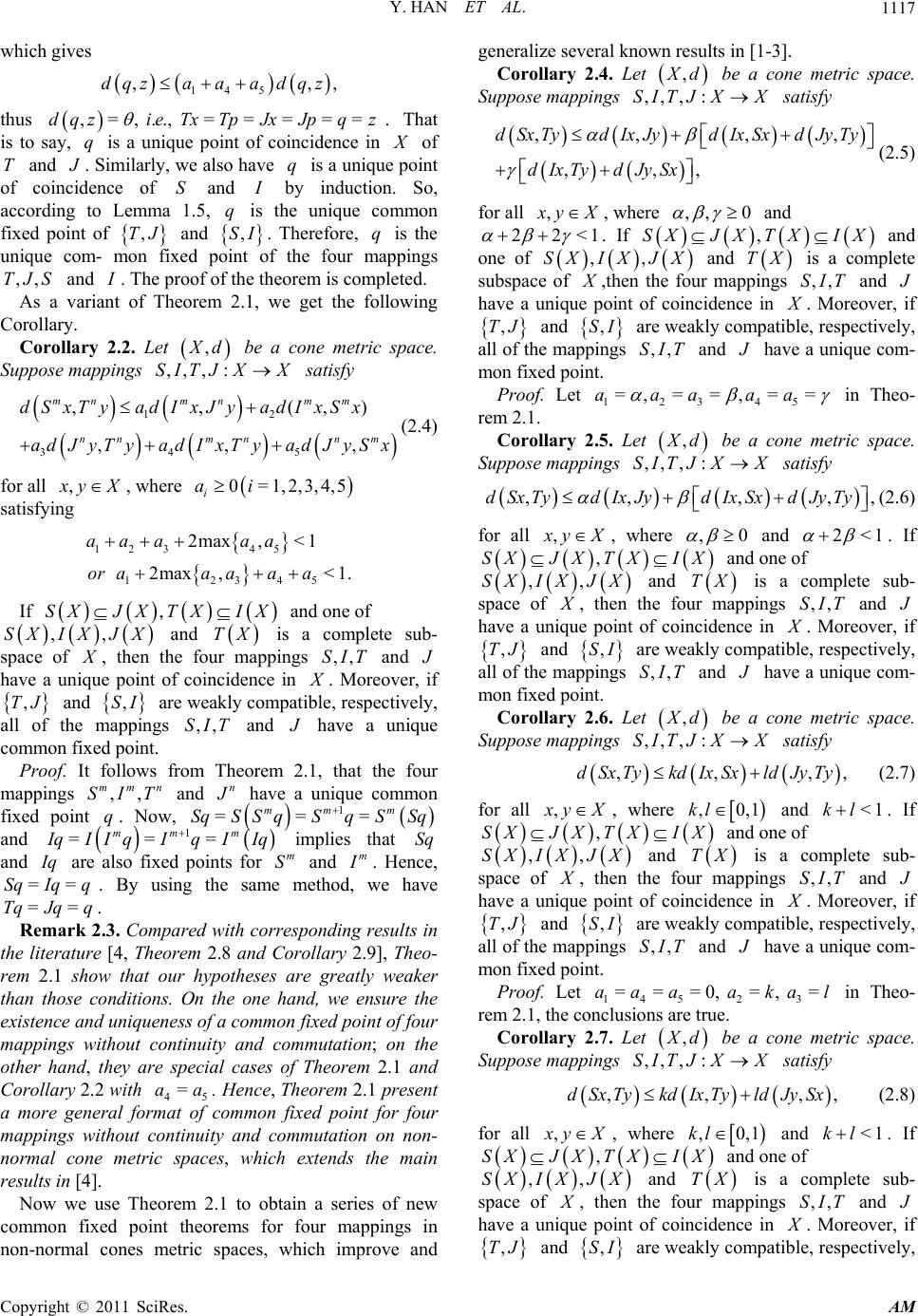 Y. HAN ET AL.1117 which gives ,, . That is to say, 145 ,dqzaaa dqz thus , =dqz, .., =====ieTxTp Jx Jpq z q is a unique point of coincidence in of T and . Similarly, we also have q is a unique oincidence of S and point of c by induction. So, according to Lemma 1.5, q is the unique comon ed point of ,TJ and m fix ,SI. Terefore, q is the unique com- mon fix point the four mappings ,,TJS and h ed of . The proof ofe theorem is completed. As a variant of Theoremwe get the following Corollary. ollary 2.2. Let , th 2.1, Cor d be a cone metric space. Suppose mappings ,, ,:SITJXX satisfy 12 ,,(,) ,,, mn mm nn nm dSxTy adIadIxSx adJyTy dJyS (2.4) 34 5 mn mn xJy adIxTy ax for all , yX, where 0=1, 2,3, 4,5 i ai satisfying 1 45 12345 2max,<1 2max,<1. aa aa r aaaaa 23 a o If and onef , SXJX TXIX ,,IXJX and o SX TX space of is a comlete sub- p , then the four mappings ,,SIT and have a unique point of coincidence in . Moreover, if ,TJ and ,SI are weakly compatible, respectively, all of the mappings ,,SIT and have a unique common fixed point. Proof. It follows from Theorem 2.1, that the four mappings ,, mm n SIT and n have a unique common fixed point q. Now, 1 === mm m Sq S S qSqSSq and 1 === mm m qIIqIqI Iq implies that Sq and q are d poinfd m also fixets or m S an . Hence, ==Sq Iq qng ==Tq Reark 2.3. Compared with corresponding results in e [4, Theorem 2.8 and Corollary 2.9], Theo- w that our hy . By usi q. ame method, we havethe s Jq m the literatur rem es metric spaces, which improve and ge 2.1 shopotheses are greatly weaker than those conditions. On the one hand, we ensure the existence and uniqueness of a common fixed point of four mappings without continuity and commutation; on the other hand, they are special cases of Theorem 2.1 and Corollary 2. 2 with 45 =aa. Hence, Theorem 2.1 present a more general format of common fixed point for four mappings without continuity and commutation on non- normal cone metric spaces, which extends the main results in [4]. Now we use Theorem 2.1 to obtain a series of new common fixed point theorems for four mappings in non-normal con neralize several known results in [1-3]. Corollary 2.4. Let , d be a cone metric space. Suppose mappings ,,,:SITJ XX satisfy ,, ,, , d SxTyd IxJydIxSxdJyTy dIxTy d (2.5) , ,JySx , yX ,for all where ,, 0 and 122< . If TX IX, SX JX and one of X and ,,J TX is a com SX I e of Xplete subspac ,then theings four mapp,,SIT and have a unique point ofn coincidence i . Moreover, if ,TJ and ,SI pi are patibweakly comle, respectively, all of the mapngs ,,SIT and haveue com- mon fixed point. of. Let2345 , ==, ==aaaa a uniq Pro 1 =a in Theo- rem 2.1. Corollary 2.5. Let , d ,, ,:SITJ be a cone metric space. Sugs satisfyppose mappin X X d ,, ,,,Sx TydIxJyIxSxdJyTy (2.6) for all , d yX , where0 , and 2<1. If IX , JX TSXXand one of SXX and ,,IX J TX is a complete sub- space of , then the four mings app, ,SIT and ence in have a nt of coiunique poincid . Moreover, if ,TJ and ,SI appings are weampatible, respectively, all of the m,,SIT and kly co haveue com- mon fixed point. ollary 2Let a uniq Cor.6. , d be a cone metric space. Suppose mappings :SIJ XX satisfy ,,,T kdIxSx ldJyTy ,,dSx ,,Ty (2.7) for all , yX , and klwhere ,0,1kl<1. If IX and one of , JX TSXX ,,IX J SXX and TX is a complete sub- space of , then the four ms ,SI apping ,T and ence in have a nt of coiunique poincid . Moreover, if ,TJ and ,SI appings are weampatible, respectively, all of the m,,SIT and kly co haveue com- mon fixed point. of. Let45 23 ==0, =, =a aa kal in Theo- rem 2.1, the conclusi true. Corollary 2.7. a uniq Pro Let 1 =a ons are , d ,, ,:SITJ be a cone metric space. Sugs satisfyppose mappin X X ,,,,dSxTyTyldJySx (2.8) for all , kdIx yX , and klwhere ,0,1kl<1 . If IX and one of , JX TSXX SXX and ,,IX J TX is a complete sub- space of , then the four ms ,SI apping ,T and ence in have a nt of coiunique poincid . Moreover, if ,TJ and ,SI are weampatible, respectively, kly co Copyright © 2011 SciRes. AM 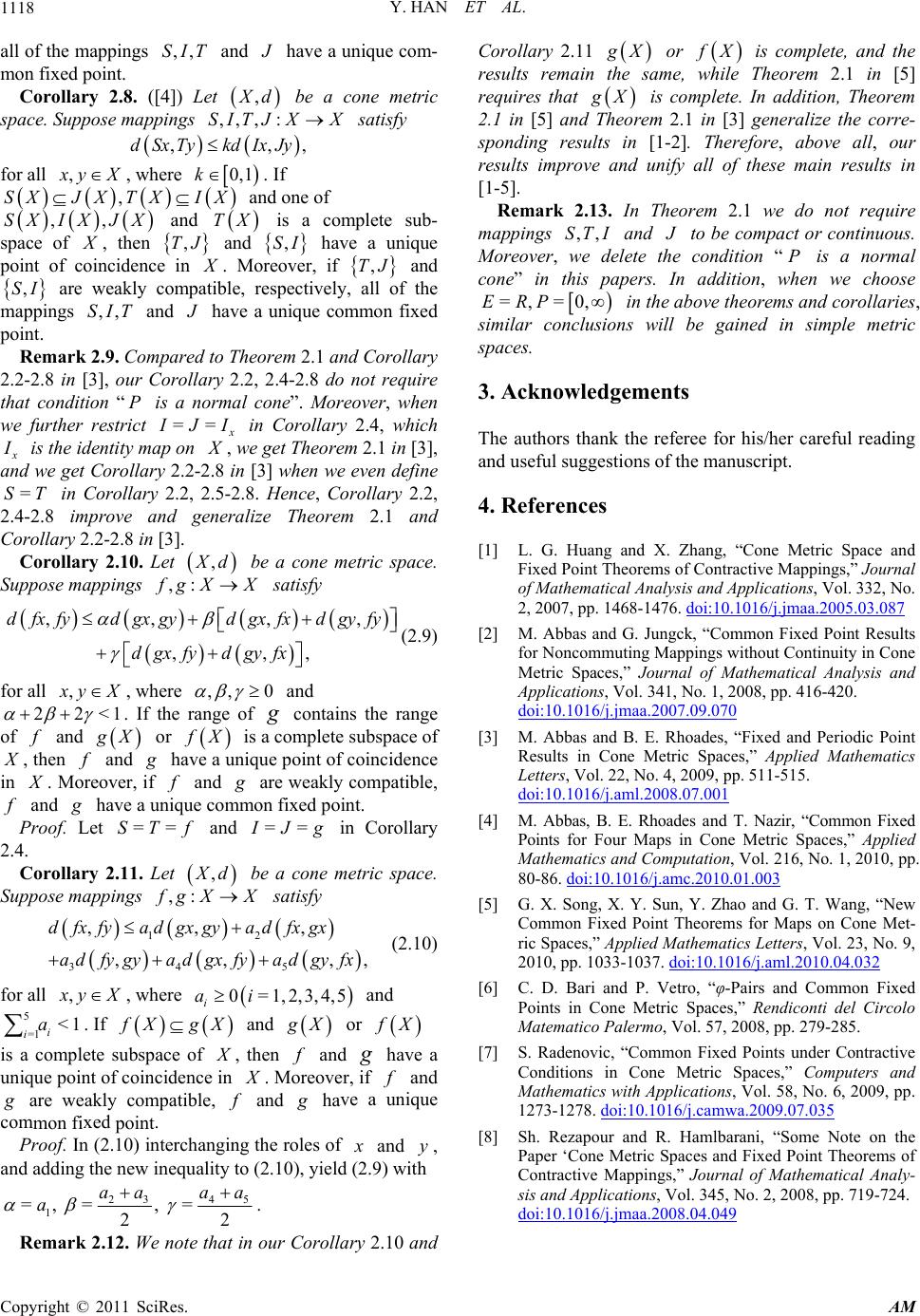 Y. HAN ET AL. Copyright © 2011 SciRes. AM 1118 aall of the mppings ,,SIT and haveque com mon fixed point. ollary ([4]) Let a uni- Cor2.8. , d be a cone metric space. Suppose mapp,, ,:SITX X satisfy dS ings xTy J ,,Ix ,kdJy for all , yX, where k . If 0,1 , SXJX TXIX and one of SX X ,,IX J and TX is a complete sub- space of , then ,T J and ,SI have a unique point of coincidence in . Moreover, if ,TJ and ,SIly are weak S c i d ompat spectively, all of the mappings ,,IT an ble, re lla is a nor have a ue common fixed point. ark 2.9. Compared to Theorem 2.1 and Corollary 2.2-2.8 in [r Corory 2.2, 2.4-2.8 do not require that cond n cone iqu Rem 3], ou ition mal ”. Moreover, when w “P e further restrict == JI in Corollary 2.4, which is the identity map on , we get Theorem 2.1 in [3], and we get Corollary 2.2-2.8 in [3] when we even define =ST in Corollary .8. Hence, Corollary 2.2, 4-2.8 improve and geeralize Theorem 2.1 and Corollary 2.2-2.8 in [3]. ollary 2.10. Let 2.2, 2. n 5-2 2. Cor , d be a cone metric space. Suppose mappings ,: gX X satisfy ,, ,, , fx fydgxgygx fxdgyfy d fx (2.9) ,, gy d d d gxfy for all , yX, where ,, 0 and 122< . If the range of contains the range of and X or X is a complete subspace of , then and ha point ofve a unique coincidence in . Moreover, if and are weakly compatible, d an ha uniqumon fixed point. P f. Let =ST fnd == ve o a = e a com ro Jg in Corollary 2.4. Corollary.11. Let , 2 d be a cone metric space. Suppose mappings ,: gX X satisfy 345 ,,,,adfygyayadgyfx for all , 12 ,,dfxfygy a,a dfxgx f dgx d gx (2.10) yX, where 0a =i1, 2,3, 4,5 i and . If 5 =1 <1 i ia XgX and X or X is a complete subspace of , then and have a oint of unique pcoincidence in . Moreover, if and are compatible, weakly and ha mon fipoint gi l ve xed a unique com. Proof. In (2.10) interchanng the ro es of and y, and adding the new inequality to.10), yield (2.9ith ) w(2 23 45 1 =, =, = 2 aa aa a . 2 Remark 2.12. We note that in our Corolla 2.10 and Corollary 2.11 ry X or X is complete, and the results remae same, weorem 2.1 in [5] requires that in thhile Th X is co addition, Theorem 2. i [ mplete. In 1 in [5] and Theorem 2.1 in [3] generalize the corre- sponding resultsn1-2]. Therefore, above all, our results improve and unify all of these main results in [1-5]. Remark 2.13. In Theorem 2.1 we do not require mappings ,,ST I and to be compact or continuous. Moreover, we delete the condition “P is a normal cone” in this papers. In addition, when we choose =, =0,RPE in the above theorems and corollaries, similar conns will be gained in simple metric spaces. 3. Acknowements The authors thank the referee for his/her careful reading nd usefu clusio ledg l suggestions of the manuscript. ppings,” Journal al Analysis and Applications, Vol. 332, No. 68-1476. doi:10.1016/j.jmaa.2005.03.087 a . References 4 [1] L. G. Huang and X. Zhang, “Cone Metric Space and Fixed Point Theorems of Contractive Ma of Mathematic 2, 2007, pp. 14 [2] M. Abbas and G. Jungck, “Common Fixed Point Results for Noncommuting Mappings without Continuity in Cone Metric Spaces,” Journal of Mathematical Analysis and Applications, Vol. 341, No. 1, 2008, pp. 416-420. doi:10.1016/j.jmaa.2007.09.070 [3] M. Abbas and B. E. Rhoades, “Fixed and Periodic Point Results in Cone Metric Spaces,” Applied Mathematics Letters, Vol. 22, No. 4, 2009, pp. 511-515. doi:10.1016/j.aml.2008.07.001 [4] M. Abbas, B. E. Rhoades and T. Nazir, “Common Fixed Points for Four Maps in Cone Metric Spaces,” Applied Mathematics and Computation, Vol. 216, No. 1, 2010, pp. 80-86. doi:10.1016/j.amc.2010.01.003 [5] G. X. Song, X. Y. Sun, Y. Zhao and G. T. Wang, “New Common Fixed Point Theorems for Maps on Cone Met- ric Spaces,” Applied Mathematics Letters, Vol. 23, No. 9, 2010, pp. 1033-1037. doi:10.1016/j.aml.2010.04.032 [6] C. D. Bari and P. Vetro, “φ-Pairs and Common Fixed Points in Cone Metric Spaces,” Rendiconti del Circolo Matematico Palermo, Vol. 57, 2008, pp. 279-285. [7] S. Radenovic, “Common Fixed Points under Contractive Conditions in Cone Metric Spaces,” Computers and Mathematics with Applications, Vol. 58, No. 6, 2009, pp. 1273-1278. doi:10.1016/j.camwa.2009.07.035 [8] Sh. Rezapour and R. Hamlbarani, “Some Note on the Paper ‘Cone Metric Spaces and Fixed Point Theorems of Contractive Mappings,” Journal of Mathematical Analy- sis and Applications, Vol. 345, No. 2, 2008, pp. 719-724. doi:10.1016/j.jmaa.2008.04.049
|